DIP Question Bank Sheetal PDF

| Title | DIP Question Bank Sheetal |
|---|---|
| Author | Anonymous User |
| Course | Digital Signal & Image Processing |
| Institution | University of Mumbai |
| Pages | 14 |
| File Size | 284.8 KB |
| File Type | |
| Total Downloads | 78 |
| Total Views | 194 |
Summary
Download DIP Question Bank Sheetal PDF
Description
Comprehensive Question Set – DIP – BE ETRX - 2017-2018
Module 1 Introduction to image processing 01 /02 mark Questions
1. What is an Image. 2. Define brightness? 3. What is dynamic range? 4. What do you meant by color model? 5. List hardware oriented colour model? 6. What is hue and saturation? 7. List applications of color models? 8. What is meant by pixel? 9. Define Digital Image? 10. Define resolution? 11. How cones and rods distributed in retina? 12. When should we use the PNG file format? 13. When should we use the JPEG file format? 14. Explain Euclidean distance? (3M) 15. Explain City Block Distance? (3M) 16. Explain Chess board distance? (3M) 17. Explain m-adjacency distance? (3M) MULTIPLE CHOICE QUESTIONS (2 Marks each) 1) Intensity levels in 8bit image are a. 128. b. 255 c. 256 d. 512 2) Total amount of energy from light source is called a. brightness. b. reflectance. c. luminance. d. radiance. 3) A continuous image is digitised at _______ points. a. Random b. Vertex
c. Contour d. Sampling 4) The transition between continuous values of the image function and its digital equivalent is called ______________ a. Quantisation b. Sampling c. Rasterisation d. None of the Mentioned 5) Early bartlane systems were capable of coding image in a. two gray levels. b. three gray levels. c. four gray levels. d. five gray level. 6) Which is first fundamental step in image processing a. filtration. b. image acquisition. c. image enhancement. d. image restoration. 5 marks Questions 1. Explain basic elements of an image processing system. (5 M) 2. Explain the concept of Half Toning (5M) 3. Explain types of images 1) Explain image file formats. (5 M) 2) Explain basic elements of an image processing system. (5 M) 3) Explain the concept of Half Toning (5M) 4) What is Image Processing? (5-10M) 5) Explain types of images. (5 M) 6) Explain image file formats. (5 M) 7) Explain isopreference curves. (5M) 8) What is non-uniform sampling? (5M) 9) Explain human visual system with in accordance with the processing of images? 10) Write short note on connectivity of pixels 11) Justify the statement “Quality of pictures depends on the number of pixels and number of gray levels representing the pictures.” 12) Explain the components of image processing system? 13) Define 4 connectivity and 8 connectivity 14) Define city block distance and Euclidean distance.
10 Marks Questions 1. How many grey levels will a half toned image have? Explain in detail. (10M) 2. Explain the effects of reducing sampling and quantization. 3. What is Sampling and Quantisation? (10 M) 4. Write short note on Image file formats. 5. Explain the effects of reducing sampling and quantization. (10 M) 6. Explain Euclidian distance, city block distance, Chess board distance and Dm distance with the help of an example.
MULTIPLE CHOICE QUESTIONS (2 Marks each) 1. Intensity levels in 8bit image are e. 128. f. 255 g. 256 h. 512 2. Total amount of energy from light source is called e. brightness. f. reflectance. g. luminance. h. radiance. 3. A continuous image is digitised at _______ points. e. Random f. Vertex g. Contour h. Sampling 4. The transition between continuous values of the image function and its digital equivalent is called ______________ e. Quantisation f. Sampling g. Rasterisation h. None of the Mentioned 5. Early bartlane systems were capable of coding image in e. two gray levels. f. three gray levels. g. four gray levels. h. five gray level.
6. Which is first fundamental step in image processing e. filtration. f. image acquisition. g. image enhancement. h. image restoration. Module 2 Image Enhancement 01 /02 mark Questions 1. What is bit plane? 2. What is image filtering 3. Why does histogram equalization not produce a perfectly flat histogram? 4. 05 mark Questions 1. What is image enhancement. (5M) 2. Distinguish between point operations and neighbourhood operations. (5M) 3. Compare and contrast low pass and high pass spatial filters. (5M) 4. What is Histogram of image? (5M) 5. Short notes on (5M each) i)
Thresholding and Grey Level Slicing.
ii) iii)
Butterworth High Pass filter Log Transformation.
iv)
High Boost filtering.
v) Power law transformation 6. Explain neighbourhood processing? 7. Explain low-pass filter? 8. Explain Low-Pass Median Filter? 9. Explain High Pass Filtering?) 10. Obtain Digital Negative of the image?
11. Show that, High Pass = Original Low pass. 12. What effect would setting to zero the lower order bit planes have on the histogram of an image in general?
13. What would be the effect on the histogram if we set to zero the higher order bit planes instead? 14. Why the sum of coefficients of high pass filter mask is zero? 15. 10 mark Questions 1. Explain spatial domain processing. (10M) 2. Explain different operations of point processing. (10M) 3. What do you mean by Gaussian noise and why is an averaging filter used to eliminate it. (10M) 4. What is salt and pepper noise and how does a median filter remove it? 5. Histogram of an image with 8 quantization levels is given below perform histogram equalization. Draw original and equalized histogram. (10M) Gray 0 1 2 3 4 5 6 7 Level No. of 220 70 50 150 130 70 150 160 Pixels 6. Explain the Homomorphic filter. Under which condition Homomorphic filter is used? (10M) 7. Explain in detail High boost filtering. (10M) 8. Explain image zooming by interpolation. Justify why it is better than zooming by replication. (10M) 9. Explain convolution is spatial domain is multiplication in frequency domain. 10. Explain steps involved in filtering in frequency domain. Also explain the gaussian filter. (10M) 11. Explain the low pass median filter. Why median filter is not suitable for eliminating Gaussian noise? How Gaussian noise can be eliminated? (10M) 12. Explain the Homomorphic filtering and its application. (10M) 13. Plot the histogram for the following image. Perform histogram equalization and then plot the equalized histogram and histogram equalized image. What will be the result equalized image is further equalized? (10M) 1 5 3 5 1 4 2
1 6 4 5 3 6 4
3 3 3 4 4 4 6
6 4 2 1 5 1 3
4 5 4 3 6 2 2
3 5 3 2 5 2 4
1 3 5 3 4 3 5
14. Explain the translation and convolution property of Fourier transform. 15. What is connectivity? Explain 4-nighbourhood, 8-neighbourhood and M-connectivity? 16. What is histogram equalization? 17. Explain High Boost Filtering? 18. Explain Zooming and its types? 19. Find the DFT of the image : 0 1 2 1
1 2 3 2
2 3 4 3
1 2 3 2
20. Explain the low pass filters of frequency domain. 21. Explain all the high pass filters of frequency domain. 22. Apply the following image enhancement techniques for the given 3 bit per pixel image segment. 2 7 2 1 1
1 1 4 3 4
2 4 1 4 1
1 3 3 6 3
0 2 7 3 4
i. Digital Negative ii. Bit plane slicing iii. Thresholding with T = 5 23. Perform histogram equalization on gray level distribution shown in table. Draw the histograms of the original and equalized images. Gray levels 0 1 2 3 4 5 6 7 No. of pixels 790 1023 850 656 329 245 122 81 24.
Module 3 (Image segmentation) 1) What is image segmentation? (5M) 2) Explain segmentation based on discontinuities and segmentation based on similarirites. (10M) 3) How are points detected in an image? (5M) 4) How are lines detected in an image? (5M) 5) How are edges detected in an image using 1st derivative approach? (10M) 6) How are edges detected in an image using 2nd derivative? (10M) 7) Show that the Laplacian operator is invariant to rotation (10M). 8) Explain the need of a LOG operator. (10M) 9) Write a short note on Canny Edge Detector. (5M) 10) Explain edge linking. (10M) 11) Explain Hough Transform. (10M) 12) Explain region based on segmentation with all its different techniques. (10M) 13) Explain image segmentation based on thresholding. (10M) 14) Explain global processing via graph theoretic techniques. (10M) 15) Explain the compass operator. (10M) 16) Explain the following techniques of region based segmentation (10M) i) Region Growing ii)
Region split and merge.
iii) iv)
Region splitting Region merging
17) Explain how Hough Transform can be used for boundary shape detection. (10M) 18) Explain why Prewitt and Sobel operator perform well on noisy image than Roberts operator. (10M) 19) Explain why image resulting from poor illumination could be quite difficult to segment. (10M) 20) List down the properties that a region has to satisfy. (5M) MULTIPLE CHOICE QUESTIONS (2 MARKS EACH) 1. Sobel is better than prewitt in image a) Sharpening b) Blurring c) Smoothing d) Contrast 2. Example of similarity approach in image segmentation is a) Edge based segmentation
b) Boundary based segmentation c) Region based segmentation d) Both A and B 3. Pixels where intensity changes abruptly are called a) Area pixels b) Line pixels c) Point pixels d) Edge pixels 4. Segmentation is a process of a) Low level processes b) High level processes c) Mid level processes d) Edge level processes 5. LoG function is also called a) Gaussian b) Gray scale image c) Gradient image d) Mexican hat 6. Sobel gradient is not that good for detection of a) Horizontal lines b) Vertical lines c) Diagonal lines d) Edges 7. Diagonal lines are angles at a) 0 b) 30 c) 45 d) 90
Module 4 (Image Transform) 1) Check whether 1-D DFT is an example of a unitary transform or not. (5M) 2) Explain Hadamard Transform. (10M) 3) Is Hadamard Matrix orthogonal? (5M) 4) Compute the Hadamard transform for given image. 2
1
2
1
1
2
3
2
2
3
4
3
1
2
3
4
(10M)
5) Given x(n) = {4, 2, 2, 4}' find X[n] using the Fast Hadamard Transform. (5M) 6) Given x(n) = {1, 2, 1, 1, 3, 2, 1, 2}', use the Fast Hadamard Transform to compute the Hadamard transform.
(10M)
7) Explain Walsh Transform. (10M) 8) Generate Walsh Transform for the given image. (10M) 2
1
2
1
1
2
3
2
2
3
4
3
1
2
3
2
9) Find Haar Transform for following signal
x(n) = {1, 2, 0, 3}
(5M)
10) Find DIT FFT of given image x(n) = {1, 2, 3, 4, 4, 3, 2, 1}. (10M) n 11) Given x(n) = 2 and N = 8, find X(k) using DIT FFT algorithm. (10M) 12) Given x(n) = {1, 2, 3, 4, 4, 3, 2, 1}, find X(k) using DIF FFT algorithm. (10M) 13) Write a short note on KLTransform. (5M) 14) Write a short note on Discrete Wavelet Transform. (5M) 15) Compute the DCT of the following Pseudo image (10M) 1 3 3 1
3 4 5 3
3 5 4 3
1 3 3 1
16) Explain the number of computation in FFT are less as compared to DFT. (5M) 17) Derive the 8x8 matrix for Walsh transform. Also show the Walsh basis function for N=4. (10M) 18) Explain DFT is example of unitary transform. (5M)
19) Explain Discrete sine transform. (5M) 20) Explain Slant transform. (5M)
Module 5 (Image Compression) 1) What is Error Criteria? (5M) 2) Explain LZW Technique. (10M) 3) Explain Predictive coding. (10M) 4) Find the arithmetic code word of the message : INDIA. (10M) 5) Differentiate between Lossless and Lossy compression. (5M) 6) Explain Redundancies in Images? (10M) 7) Explain the following redundancies (10M) a) Psychovisual redundancy b) Interpixel redundancy c) Coding redundancy 8) Explain the role of data fidelity criteria in image compression. (5M) 9) Explain JPEG. (10M) 10) Explain Run length encoding in loss less compression (10M) 11) Explain Transform coding. (10M) 12) Short note on IGS Coding. (5M) 13) 4) Explain the arithmetic coding with suitable example. (10M) 14) Find the Huffman code for the following stream data {a,a,a,a,a,a,a,b,b,b,c,c,c,c,c,c,d,d,d,d,d,d,d,d,d,d,e,e,e,e,f,f} 15) Find the Huffman code for the following data points {2,2,2,2,2,2,2,4,4,4,4,4,4,3,3,3,3,3,1,1,1,1,5,5,5,6,6,7} 16) Explain LZW compression with suitable example. MULTIPLE CHOICE QUESTIONS (2 Marks each) 1. Information is the a. data b. meaningful data c. raw data d. Both A and B
2. System of symbols to represent event is called a. storage b. word c. code d. nibble
(10M) (10M)
(10M)
3. Huffman coding is an encoding algorithm used for a. lossy data compression b. files greater than 1 Mbit c. lossless data compression d. broadband systems
4. Irrelevant data is known as a. Redundant data b. Meaningful data c. Raw data d. Both A and B 5. Image compression comprised of a. encoder b. decoder c. frames d. Both A and B
6. Replication of pixels is called a. coding redundancy b. spatial redundancy c. temporal redundancy d. both b and c
7. Information lost when expressed mathematically is called a. markov b. finite memory source c. fidelity criteria d. noiseless theorem
Module 6 (Morphology) 1) What is Image Morphology? (5M) 2) Which are the arithmetic and logical operations of Image Morphology? (5M) 3) What is Dilation? (5M) 4) What is Erosion? (5M) 5) Explain Opening and Closing. (10M) 6) Explain Region filling. (10M) 7) Write a short note on Hit or Miss Transformation. (10M) 8) Explain Thinning and Thickening. (10M) 9) Write a short note on Skeletonization. Draw the skeleton of triangle (10M) 10) Write a short note on Pruning. (5M) 11) Explain the boundary extraction. (5M) 12) Explain the morphological operations of opening and closing with example. (10M) 13) Short Note on Dilation and erosion (10M) 14) For given image find moments (10M) 1 1 2 3 4
3 2 3 1
2 1 3 2 0
3 2 2 0 3
4------Y 2 1 1 2
| | X M(0,0), m(1,0), m(0,1), m(1,1), m(2,0). 15) Explain 1st difference of a chain code makes it invariant to rotation. (5M) 16) Explain Signatures (5M) 17) Explain moments. (5M) MULTIPLE CHOICE QUESTIONS (2 MARKS EACH) 1. Closing is represented by a. b. c. d.
A .B A+B A-B AxB
2. Structuring elements runs over image's
a. b. c. d.
Rows columns edges every element
3. Dilation followed by erosion is called a. opening b. closing c. blurring d. translation
4. Opening smooths image's a. pixels b. lines c. contour d. boundary
5. Structuring element is also called a. pixels b. lines c. subimage d. noise
6. Erosion followed by dilation is called a. opening b. closing c. blurring d. translation
7. Hit-or-miss transformation is used for shape a. removal b. detection c. compression d. decompression
8. Erosion is used for object a. removing lines b. producing lines c. blurring image d. sharpening image...
Similar Free PDFs

DIP Question Bank Sheetal
- 14 Pages

Dmdw-question bank - question bank
- 17 Pages

Question bank
- 8 Pages
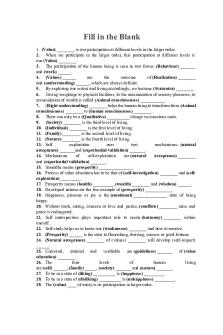
Question Bank 3question bank
- 6 Pages

Question BANK
- 19 Pages
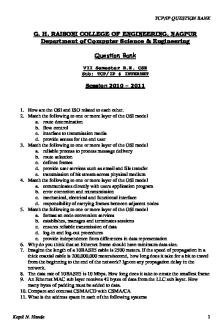
Tcp-ip-question-bank
- 25 Pages

Chapter 4 - Question Bank
- 28 Pages
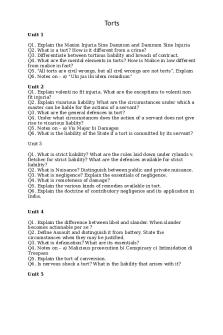
Torts Question Bank
- 2 Pages
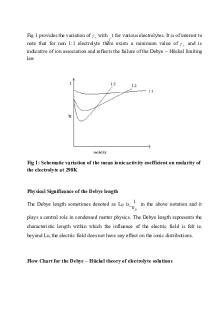
QB5 - Question Bank 5
- 104 Pages

Assessment Question Bank 1
- 22 Pages
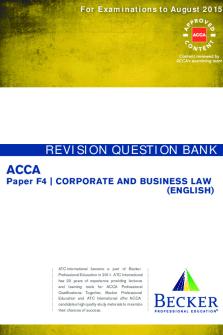
Revision Question Bank 60
- 154 Pages
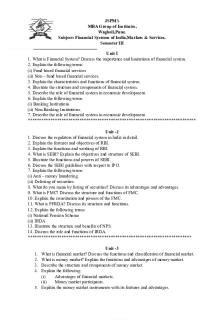
Fsims Question Bank
- 4 Pages

11. Autocad question bank
- 14 Pages
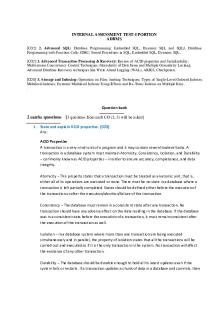
Question bank Adbms - solution
- 45 Pages

Viva Question Bank - CSS
- 17 Pages

Strategic Management Question Bank
- 29 Pages
Popular Institutions
- Tinajero National High School - Annex
- Politeknik Caltex Riau
- Yokohama City University
- SGT University
- University of Al-Qadisiyah
- Divine Word College of Vigan
- Techniek College Rotterdam
- Universidade de Santiago
- Universiti Teknologi MARA Cawangan Johor Kampus Pasir Gudang
- Poltekkes Kemenkes Yogyakarta
- Baguio City National High School
- Colegio san marcos
- preparatoria uno
- Centro de Bachillerato Tecnológico Industrial y de Servicios No. 107
- Dalian Maritime University
- Quang Trung Secondary School
- Colegio Tecnológico en Informática
- Corporación Regional de Educación Superior
- Grupo CEDVA
- Dar Al Uloom University
- Centro de Estudios Preuniversitarios de la Universidad Nacional de Ingeniería
- 上智大学
- Aakash International School, Nuna Majara
- San Felipe Neri Catholic School
- Kang Chiao International School - New Taipei City
- Misamis Occidental National High School
- Institución Educativa Escuela Normal Juan Ladrilleros
- Kolehiyo ng Pantukan
- Batanes State College
- Instituto Continental
- Sekolah Menengah Kejuruan Kesehatan Kaltara (Tarakan)
- Colegio de La Inmaculada Concepcion - Cebu